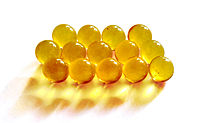
Photo from wikipedia
Drug-induced liver injury (DILI) is the main cause of liver damage mediated by the excretion of toxic active drug metabolites. Omega-3 fatty acids and vitamin C have potent antioxidant, anti-inflammatory,… Click to show full abstract
Drug-induced liver injury (DILI) is the main cause of liver damage mediated by the excretion of toxic active drug metabolites. Omega-3 fatty acids and vitamin C have potent antioxidant, anti-inflammatory, and antiapoptotic effects that could offer protection against oxidative stress and liver damage. This study evaluated the hepatoprotective effect of omega-3 and vitamin C alone as well as in a combined form in methotrexate- (MTX-) induced acute liver injury in mice. Male ICR mice of seven groups (7 mice per group) were used. Groups 1 (control group) and 2 (MTX) received 0.9% saline/day (po) for 9 days. Groups 3 and 4 received 100 and 200 mg/kg bw/day omega-3 (po), respectively, for 9 days. Groups 5 and 6 received 100 and 200 mg/kg bw/day vitamin C (po), respectively, for 9 days, while group 7 received omega-3 (100 mg/kg bw/day) and vitamin C (100 mg/kg bw/day) (po) for 9 days. All animals in groups 2 to 7 received 20 mg/kg/day MTX (I.P.) once on the 10th day. Our results revealed that MTX significantly induced the elevation of transaminases, alkaline phosphates (ALP), lactate dehydrogenase (LDH), and malonaldehyde (MDA) while depleting the levels of superoxide dismutase (SOD) and glutathione (GSH) when compared to the control group. Treatment with omega-3 fatty acids or vitamin C significantly attenuated the antioxidants and biochemical alterations in a dose-independent manner. Our molecular docking study of ligand-receptor interaction revealed that both ascorbic acid and omega-3 docked well to the binding cavity of LDH with high binding affinities of –5.20 and –4.50 kcal/mol, respectively. The histopathological features were also improved by treatment with omega-3 and vitamin C. The combined form of omega-3 and vitamin C showed a remarkable improvement in the liver enzymes, oxidative stress biomarkers, and the histopathological architecture of the mice. Conclusively, the combination of omega-3 and vitamin C demonstrated a synergistic therapeutic effect against MTX-intoxicated mice, hence representing a potential novel strategy for the management of drug-induced liver disorders.
Journal Title: BioMed Research International
Year Published: 2022
Link to full text (if available)
Share on Social Media: Sign Up to like & get
recommendations!